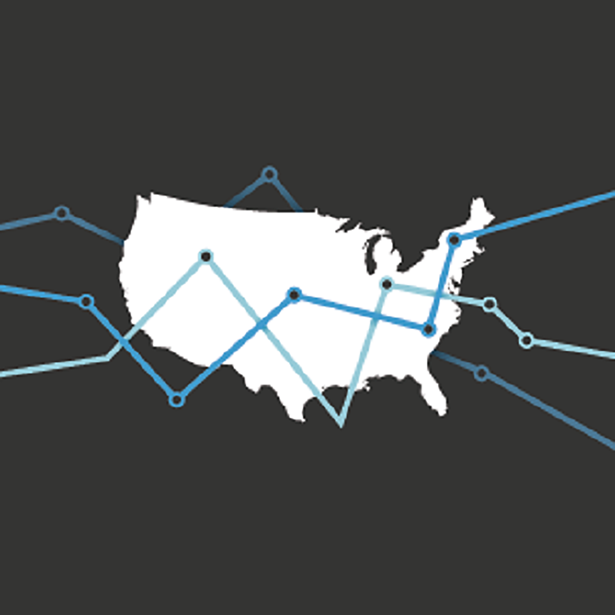Pandemic Drives Historic State Tax Revenue Drop
Editor's note: Updated state tax revenue data has been released since this analysis was published. To see more recent data and analysis, visit “State Tax Revenue Passes a Recovery Milestone.”
Total state tax revenue was down $46.4 billion from its pre-pandemic level in the four quarters ending June 30, 2020—the past budget year for nearly all states. Tax collections had been growing in most states until the COVID-19 outbreak but then took their steepest plunge in at least 25 years in the final quarter. Although at least some of this drop was expected to be recovered in the third quarter, nearly half of states still project revenue declines this fiscal year.
State tax revenue from April through June 2020 collectively was lower by an extraordinary 25% from the same quarter of 2019. Receipts fell after the public health emergency disrupted large parts of the economy and set off a recession. But much of the sudden shortfall was due to the federal government’s decision—copied by nearly all states—to delay the April 15th income tax filing deadline until July 15th. The delay pushed large sums of state personal and corporate income tax payments into the first quarter of the current fiscal year, aggravating the strain on many states’ budgets last fiscal year.
Thankfully for states, gains made before the pandemic helped offset some of the losses. Even with an influx of federal stimulus dollars, however, at least 19 states were forced to pull back on spending and at least 15 tapped into their rainy day funds to balance their fiscal 2020 budgets. It was the first of at least three fiscal years in which state revenue is expected to be battered by the pandemic. In December 2020, Moody’s Analytics projected that state general fund revenue losses would total $173 billion nationwide from fiscal 2020 through fiscal 2022, compared with inflation-adjusted fiscal 2019 levels.
Total nominal tax collections from July 2019 through June 2020 fell 4.3%, or $46.4 billion below fiscal 2019’s pre-pandemic totals, according to preliminary data from the Urban Institute. After accounting for inflation, the decline was 5.6%, or $61.2 billion. Forty-three states recorded tax revenue drops for the fiscal year, but just three states—California, New York, and Texas—accounted for more than half of the shortfall in inflation-adjusted dollars. Lower personal income tax revenue made up two-thirds of the 50-state decline, much of it due to the three-month postponement of April tax filings that usually net states’ largest monthly income tax receipts of the year.
According to the Urban Institute, 15 states reported the delayed personal income tax payments received in July retroactively as part of fiscal 2020 revenue, while most others booked the revenue in the third quarter and toward this year’s budget. Although it is not reflected in the data, California and perhaps additional states that reported the delayed funds in the third quarter also ultimately recognized at least some of the payments as part of fiscal 2020, so the percentage decrease in tax revenue shown here may be greater than the actual effect on some states’ budgets last year.
Because of differences in when states booked these delayed payments, the data for fiscal 2020 does not allow a fair state-to-state comparison of the pandemic’s initial effect on tax dollars, as some states counted substantial amounts of revenue that others deferred. But it does allow general comparisons of the size of tax revenue declines faced by policymakers last year as they attempted to close out what for most states was the first budget affected by the pandemic. Besides their treatment of income tax payments, states’ results also varied depending on their reliance on specific tax streams, economic diversity, and differences in COVID-19 caseloads and public health restrictions.
State highlights
A comparison of inflation-adjusted tax receipts reported for July 2019 through June 2020, the budget year for most states, with fiscal 2019 pre-pandemic totals shows:
- Among the 43 states in which tax revenue fell, four had declines greater than 10%: Alaska (-33.6%), North Dakota (-13.2%), Oregon (-12.3%), and California (-11.1%). Four had losses of less than 1%: Kentucky (-0.2%), Illinois (-0.4%), Wisconsin (-0.7%), and Tennessee (-0.9%). California’s drop excludes substantial income tax receipts that were delayed, although at least some of that money was applied retroactively to the state’s fiscal 2020 budget.
- West Virginia (-8.7%) recorded its greatest percentage decline in at least 25 years. The state had flat to negative growth in all four quarters, but it also was missing its April income tax payments because of the filing delay.
- Of the seven states that collected more tax revenue, Idaho (7.1%) and South Dakota (0.8%) were the only ones to report gains in 2020’s second quarter, after adjusting for inflation. Among other factors, both benefited from the first full fiscal year collecting sales taxes on online purchases and were among just a small handful of states to post increases in sales tax revenue after the pandemic hit. The other five states with increases had enough gains earlier in the budget year to completely offset year-over-year declines in the second quarter: Washington (3.8%), Maine (2.6%), South Carolina (1.9%), Virginia (0.6%), and Nebraska (0.4%).
Recent trends
The coronavirus pandemic broke a nearly uninterrupted chain in annual growth since state tax revenue began recovering in 2010 from the Great Recession of 2007-09. All major state tax streams fell after the economy plunged into a new recession in February 2020 amid a historic spike in unemployment to nearly 15%, a stunning but short-lived stock market crash, and business closures and restrictions on public gatherings to control the virus.
Although state tax revenue suffered from the economic fallout, a major driver of the $46.4 billion revenue decline (unadjusted for inflation) in the four quarters ending June 30th was the postponed deadline for filing personal and corporate income taxes. Tax revenue totals reported by more than half of the 41 states with broad-based personal income taxes did not include the delayed income tax payments, according to the Urban Institute. That means states such as Missouri and Oregon that reported large percentage drops in tax revenue for the period covering fiscal 2020 did not actually lose that much money; instead some of it was postponed to the current fiscal year.
Tax revenue gains in the first eight months of fiscal 2020 softened the blow after the pandemic hit. For example, sales tax revenue, the second-largest source of tax dollars after personal income taxes, fell 13.2% in the second quarter of 2020 from a year earlier but ended the fiscal year up slightly, according to the Urban Institute. Still, because most states had counted on growth in all their major tax streams when they passed their fiscal 2020 budgets, anything less than that contributed to budget gaps that states had to fill.
States dependent on natural resources, such as Alaska, North Dakota, and Wyoming, and on tourism, such as Hawaii, Nevada, and Florida, took the brunt of tax revenue hits in the second quarter of 2020, after the COVID-19 outbreak struck. Weak energy prices resulted in major severance tax declines in energy states. No major tax stream in tourism-dependent states went unscathed as job losses within the leisure and hospitality industry, travel restrictions, and temporary business closures contributed to declines in personal income, sales, and gaming taxes.
Revenue losses for fiscal 2020, though, turned out to be not as dire as many states and economic experts had forecast at the outset of the pandemic, thanks to federal aid that helped support businesses and unemployed workers, a quicker fall in the unemployment rate than originally anticipated, and higher-wage professions that widely escaped job losses.
What’s next?
A tremendous amount of unpredictability about the course and severity of the pandemic leaves unclear how the economy and state tax revenue trends ultimately will be affected.
Although preliminary data from the Urban Institute shows that average total monthly tax collections through November have fared slightly better than the same period a year earlier (excluding July when the delayed income tax filing artificially boosted receipts), forecasters expect state tax revenue declines once the current fiscal year is over—and beyond. Moody’s Investors Service in December estimated that state tax collections would fall by up to another 5% in fiscal 2021. Pew research found that nearly half of states project general fund revenue to decline in fiscal 2021 from fiscal 2020, with most anticipating reductions on top of prior losses, according to their most recent revenue forecasts. Although the latest available forecasts show fiscal 2021 declines in many states to be less dire than initially anticipated, a winter surge of COVID-19 cases and fresh job losses across much of the country have created new uncertainty about tax revenue trends.
Heading into the recession
Going into the pandemic-induced recession, state tax revenue collectively had recovered to a high of 18.7% greater than its peak before plunging during the Great Recession, after adjusting for inflation and averaging across four quarters to smooth seasonal fluctuations. The sudden plunge in tax dollars in the second quarter of 2020 left state tax revenue at 9.6% higher than in 2008.
By the end of 2019,44 states had fully recovered their tax revenue losses from the last recession, after adjusting for inflation. Nationally, tax revenue recovered in mid-2013, after nearly five years. Each state rebounded at substantially different paces over what became the longest economic expansion in U.S. history—depending on their unique economic conditions and policymakers’ decisions to hike or cut taxes. For example, North Dakota was the first state to surpass its Great Recession-era peak, in 2010—after just six quarters (1.5 years)—while Michigan and Virginia each took 47 quarters (11.75 years) to fully recover their tax revenue losses.
Each state’s tax collection growth since the last recession helped shape how prepared its finances were for the economic and public health shocks inflicted by the coronavirus in 2020. Extra tax dollars were central to a state’s ability to rebuild its rainy day funds to prepare for the next recession or to catch up on investments and spending that had been cut or deferred during the last downturn.
State budgets do not adjust revenue for inflation, so percentage changes presented here may differ from tax revenue figures in states’ documents. Without adjusting for inflation, 50-state tax revenue as of the final quarter of 2019 was 41.3% above its Great Recession-era peak, and tax collections had fully recovered in 48 states—all except Alaska and Wyoming. Unadjusted figures do not take into account changes in the price of goods and services.
Adjusting for inflation is just one way to evaluate state tax revenue changes. Different insights would be gained by tracking revenue relative to population growth or state economic output.
As of the latest available data provided on Dec. 4, 2020, about three-quarters of states had finalized tax receipts for fiscal 2020. Consequently, states’ annual and quarterly figures may change when finalized data is available.
Download the data to see individual state trends from the first quarter of 2006 to the second quarter of 2020. Visit The Pew Charitable Trusts’ interactive resource Fiscal 50: State Trends and Analysis to sort and analyze data for other indicators of state fiscal health.









